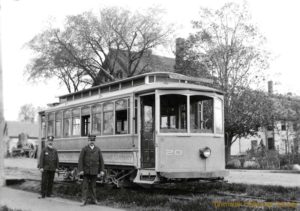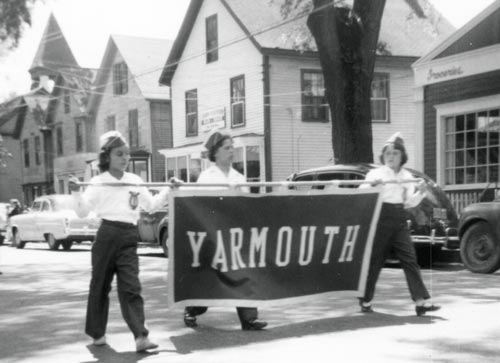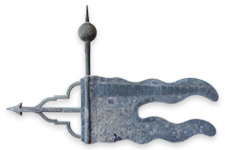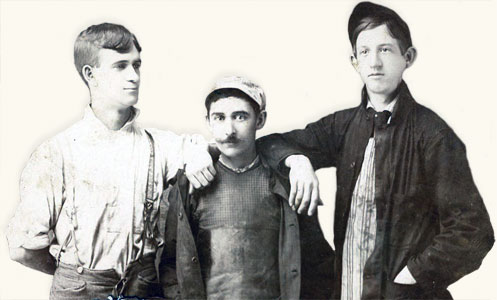 Yarmouth at the turn of the twentieth century was growing and changing. Brickyard Hollow was filled in with the black ash from the paper mill in an effort to unify the two villages. A grammar school was built in 1890 and a high school was built in 1900 replacing most of the the nine separate one-room schoolhouses. Merrill Memorial Library was built in 1904. Taxes from the mills helped finance many of the town’s improvements. Changes in transportation such the trolley lines and steamer boats made Cousins and Littlejohn Islands tourist destinations. The trolley system ran from Portland to Bath with stops in Yarmouth. In 1955, a bridge was built to Cousins Island to facilitate the construction of a power plant. With the bridge, residents could live on the islands year round. In 1961, despite unanimous disapproval by the town, the state built Route 295 across Yarmouth harbor separating the waterfront from the town. Suburban home developments began to appear and Yarmouth has consistently grown in population. One of the best-known events in Yarmouth is the Yarmouth Clam Festival held every July since 1965. Its roots date back to militia musters in the early 19th century when large crowds of spectators would come to watch from all over the state. By 1900 this tradition had evolved into the fireman’s musters that featured competing teams from all over the state. The tradition of the muster continues today.
Yarmouth at the turn of the twentieth century was growing and changing. Brickyard Hollow was filled in with the black ash from the paper mill in an effort to unify the two villages. A grammar school was built in 1890 and a high school was built in 1900 replacing most of the the nine separate one-room schoolhouses. Merrill Memorial Library was built in 1904. Taxes from the mills helped finance many of the town’s improvements. Changes in transportation such the trolley lines and steamer boats made Cousins and Littlejohn Islands tourist destinations. The trolley system ran from Portland to Bath with stops in Yarmouth. In 1955, a bridge was built to Cousins Island to facilitate the construction of a power plant. With the bridge, residents could live on the islands year round. In 1961, despite unanimous disapproval by the town, the state built Route 295 across Yarmouth harbor separating the waterfront from the town. Suburban home developments began to appear and Yarmouth has consistently grown in population. One of the best-known events in Yarmouth is the Yarmouth Clam Festival held every July since 1965. Its roots date back to militia musters in the early 19th century when large crowds of spectators would come to watch from all over the state. By 1900 this tradition had evolved into the fireman’s musters that featured competing teams from all over the state. The tradition of the muster continues today.
 Yarmouth has maintained its village characteristics primarily by maintaining a Main Street that is reminiscent of earlier days. The Village Improvement Society, founded in 1911, has been active in preservation and education in the town. To celebrate the 100th anniversary of the organization, interpretative signs were placed along the Royal River to bring attention to the industrial nature of the area. The Yarmouth History Center at 118 East Elm Street adjacent to the river has an interpretive gallery that focuses on the history of the region and also offers exhibits of local art, a Yarmouth-themed gift shop, engaging programs, and community space. Yarmouth is a vibrant town that has an arts center, a music center and a public school system that consistently ranks in the top tier. In addition, North Yarmouth Academy is centrally located in the town and has a program that attracts students from all over the world.
Yarmouth has maintained its village characteristics primarily by maintaining a Main Street that is reminiscent of earlier days. The Village Improvement Society, founded in 1911, has been active in preservation and education in the town. To celebrate the 100th anniversary of the organization, interpretative signs were placed along the Royal River to bring attention to the industrial nature of the area. The Yarmouth History Center at 118 East Elm Street adjacent to the river has an interpretive gallery that focuses on the history of the region and also offers exhibits of local art, a Yarmouth-themed gift shop, engaging programs, and community space. Yarmouth is a vibrant town that has an arts center, a music center and a public school system that consistently ranks in the top tier. In addition, North Yarmouth Academy is centrally located in the town and has a program that attracts students from all over the world.



